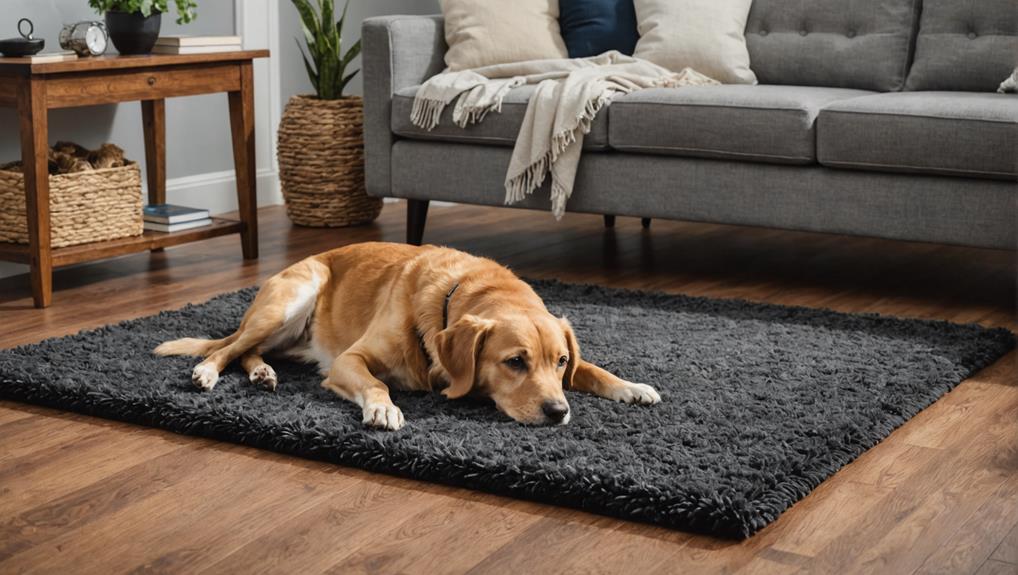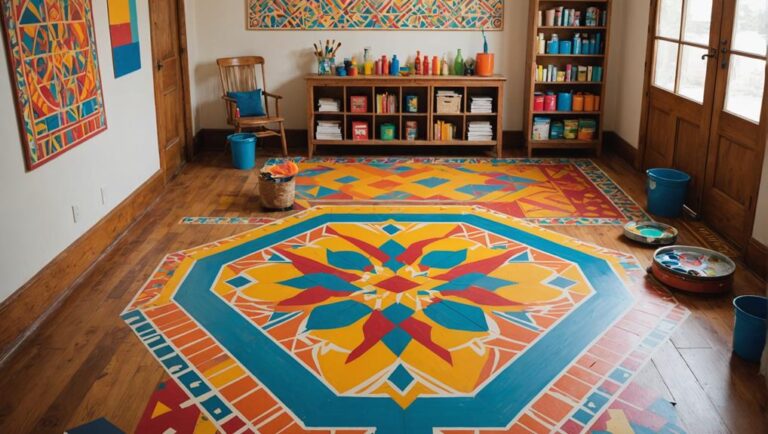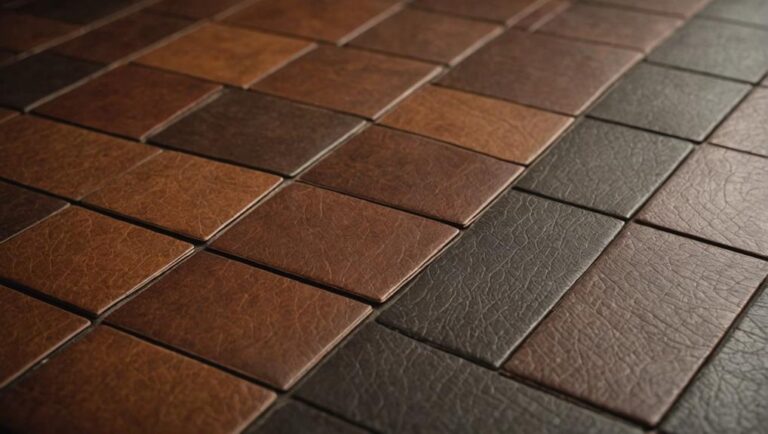To protect your floors from pet claws and nails, start by understanding the damage different claw types can cause. Opt for durable flooring options like luxury vinyl, laminate, or ceramic tiles that resist scratches. Regularly trimming your pet's nails reduces potential floor damage. Use area rugs in high-traffic zones for extra protection and apply protective coatings to existing floors. Establish designated spaces for your pets with appropriate flooring to minimize wear. Maintaining a clean environment helps preserve your floors, too. By exploring various protective strategies, you can continually enhance your home's safety and aesthetics for your furry friends.
Understanding Pet Claw Damage
When it comes to pet ownership, understanding how pet claws can damage your floors is vital for maintaining your home. Different claw types, such as those from dogs and cats, can affect flooring materials in varying ways. For instance, dog claws are typically more robust and can create deeper scratches compared to cat claws, which may leave finer marks but can still be damaging over time.
Pet behavior plays an important role in how these damages occur. If your pet tends to run around or jump frequently, the impact of their claws on your floors increases considerably. This action can exacerbate wear and tear, causing unsightly scratches and dents. Even if your pet is well-behaved, regular activities like scratching or digging can result in gradual damage.
It's important to think about the frequency and intensity of your pet's movements. For example, a high-energy dog or an indoor cat with a penchant for climbing can pose larger threats to your flooring than quieter pets. Additionally, the type of flooring you have will interact differently with various claw types. Harder surfaces like hardwood might show scratches more prominently, while softer materials might be more susceptible to dents.
To minimize potential damage, understanding these dynamics is key. By being aware of the claw types and pet behaviors that contribute to floor damage, you can take proactive measures to protect your home from wear and tear caused by your beloved pets.
Choosing Durable Flooring Options
When selecting flooring for a home with pets, opting for hard surface materials can provide significant benefits. These surfaces typically offer better scratch resistance and durability compared to softer options. Understanding the various scratch-resistant materials available can help you make an informed decision that protects your investment while accommodating your furry friends.
Hard Surface Flooring Benefits
Selecting the right flooring can greatly impact both the aesthetics and functionality of your home, especially in pet-friendly environments. Hard surface flooring options, such as tile, laminate, or vinyl, offer numerous benefits that make them ideal for households with pets. These materials provide a solid foundation that resists damage from claws and nails, ensuring your floors maintain their integrity over time.
In addition to their durability, hard surface floors are easy to clean, an essential factor for pet owners. Accidents happen, and having flooring that can be swiftly wiped down minimizes the risk of stains and odors lingering in your home. Moreover, these surfaces don't harbor allergens like carpets do, promoting a healthier living environment for both you and your pets.
When considering flooring aesthetics, hard surfaces are available in various designs and finishes, allowing you to achieve the look you desire while ensuring functionality. You can choose from sleek modern tiles to rustic wood-like laminates, so you won't have to compromise on style for safety. Ultimately, investing in hard surface flooring is a practical choice that enhances your home's appearance while protecting it from the wear and tear of pet life.
Scratch-Resistant Material Options
Choosing scratch-resistant materials is essential for maintaining the appearance and longevity of your flooring in a pet-friendly home. You'll want to explore various options that can withstand the wear and tear from your furry friends. Vinyl flooring, particularly luxury vinyl, is a popular choice due to its durability and ease of maintenance. Laminate options also provide a robust surface that resists scratches while mimicking the look of hardwood.
Ceramic tiles are another excellent choice, offering a hard surface that's impervious to scratches. If you prefer something softer, cork flooring can absorb impacts, although it may require additional care to maintain its appearance. For those seeking hardwood alternatives, consider engineered wood, which features a scratch-resistant finish.
Rubber flooring is an ideal choice for areas where pets play, providing a cushioned surface that withstands claw marks. Epoxy coatings can be applied to concrete finishes to create a tough, easy-to-clean surface. Finally, if you're looking for comfort, explore carpet choices with stain-resistant fibers that offer some scratch protection. By selecting these scratch-resistant materials, you'll keep your floors looking great while ensuring a safe space for your pets.
Regular Nail Trimming Practices
Regular nail trimming is essential for maintaining both your pet's comfort and the condition of your floors. Overgrown nails can cause discomfort for your pet and lead to scratches on your flooring. To guarantee a safe and effective trimming experience, it's important to adopt proper nail trimming techniques and utilize the right grooming tools.
Start by selecting appropriate grooming tools, such as nail clippers or a grinder. Nail clippers come in various styles, including guillotine and scissor types. Choose one that you find comfortable to use. If you're opting for a grinder, make sure it's designed for pets, as these are often quieter and less intimidating.
Before trimming, familiarize yourself with the anatomy of your pet's nails. Identify the quick, which is the pinkish area that contains blood vessels and nerves. Avoid cutting into this area, as it can cause pain and bleeding. If your pet has dark nails, trim a small amount at a time to prevent accidental injury.
Establish a routine for trimming your pet's nails, ideally every 3-4 weeks. Make the experience positive by offering treats and praise, ensuring that your pet associates the process with comfort and care. If you're unsure or anxious about trimming, consider consulting a professional groomer or veterinarian for guidance.
Using Protective Floor Coverings
A well-placed protective floor covering can serve as an important barrier against the damage caused by your pet's claws. Selecting the right floor covering materials is vital for safeguarding your flooring. Options such as vinyl, laminate, and engineered hardwood are known for their durability and scratch resistance. These materials not only protect against scratches but also offer easy maintenance, making your life simpler.
In addition to choosing resilient materials, consider applying protective coatings to your existing floors. These coatings create an additional layer of defense, greatly reducing the risk of damage from your pet's claws. High-quality polyurethane or epoxy coatings can enhance the surface's durability, making it more resistant to scratches, dents, and stains. Applying these coatings is generally straightforward, and many products are available for DIY enthusiasts.
It's also important to verify that the protective floor coverings you choose are non-toxic and safe for your pets. Research the materials and coatings to confirm they meet safety standards. You want to prevent any adverse reactions while providing a safe environment for your furry friends.
Implementing Area Rugs and Mats
To effectively protect your floors from pet claws, implementing area rugs and mats can be a game changer. You'll want to choose the right material that withstands wear while providing comfort for your pets. Additionally, strategic placement and easy maintenance tips can enhance their protective benefits.
Choosing the Right Material
When it comes to protecting your floors from the wear and tear of pet claws, choosing the right materials is essential. Start with area rugs and mats designed for durability. Look for options made from synthetic fibers like nylon or polypropylene, which offer resilience against scratches while being easy to clean. These materials also come in various flooring textures, providing the grip necessary to prevent slips, not just for you, but for your pets as well.
Consider the aesthetic considerations of your space. You want materials that complement your home's design while still serving a protective function. Patterns and colors that hide pet hair and scratches can be particularly practical. Opt for darker shades or busy designs, as they can effectively disguise wear and tear.
Additionally, think about the thickness of your mats. A thicker rug can absorb impact better, reducing the risk of floor damage. Always guarantee that the materials chosen are non-toxic and safe for your pets to avoid any health risks. By selecting the right materials, you'll safeguard your floors and maintain an inviting atmosphere in your home.
Placement for Maximum Protection
Placing area rugs and mats strategically can greatly enhance floor protection against pet claws. Start by identifying your pet zone, which is typically where your pets spend most of their time, such as near furniture or their favorite resting spots. Arrange your furniture to create a defined space that naturally directs your pets to these protective areas.
Next, choose rugs with durable, high-pile materials that can withstand wear and tear. Position these rugs in high-traffic areas, particularly where your pet frequently enters and exits rooms. This will help absorb the impact of their claws and minimize scratches on your flooring. It's also essential to guarantee that the rugs are secured to prevent slipping, as this could lead to accidents for both you and your pets.
Additionally, consider placing mats at entrances to your home, as they can catch dirt and debris, further protecting your floors. By thoughtfully integrating these elements into your furniture arrangement, you can create a safe and protective environment for your floors, prolonging their lifespan while keeping your pets comfortable.
Easy Maintenance Tips
Maintaining area rugs and mats is vital for keeping your floors protected from pet claws while guaranteeing a clean and inviting home. Regular cleaning is important; vacuum your rugs at least once a week to remove loose fur and debris. For deeper cleaning, use pet-friendly products that won't harm your rugs or floors. Spot-clean stains immediately using a damp cloth and a mild detergent to prevent odors and discoloration.
Consider using washable rugs or mats, as they're easier to maintain and can withstand frequent cleaning. When selecting rugs, opt for materials like nylon or polyester, which are durable and resistant to wear from pet claws.
Additionally, place mats in high-traffic areas where your pets typically roam. This will protect your floors and make cleaning easier. If you notice any fraying or damage, address it promptly to prevent further deterioration and guarantee safety.
Training Your Pets to Stay Off
Training your pets to stay off certain areas can greatly protect your floors from damage caused by claws. Implementing a structured approach using positive reinforcement can markedly enhance your success. Start by identifying the areas you want to keep pet-free, such as carpets or hardwood floors.
Begin training by establishing clear boundaries. Use physical barriers like gates or mats in the designated areas to signal to your pets where they shouldn't go. When they approach these spaces, calmly redirect them to a more acceptable location. It's essential to be consistent; every time they venture onto the restricted surface, gently guide them back.
Incorporate a reward system to encourage desired behaviors. When your pet stays off the restricted areas, immediately praise them and offer a treat. This positive reinforcement creates a clear association between good behavior and rewards. Over time, your pet will learn that staying off certain surfaces leads to positive outcomes.
To reinforce this training, consider using commands such as "off" or "stay." When your pet responds correctly, reward them with praise or treats. Repetition and consistency are key; reinforce these behaviors daily for the best results.
Additionally, make sure to provide alternative spaces where your pets can relax and feel comfortable. By creating positive experiences in these areas, you'll help them understand where they're welcome. With patience and dedication, your pets will learn to respect your home's boundaries, ultimately protecting your floors from potential damage.
Applying Floor Protective Products
To safeguard your floors from the wear and tear caused by pet claws, applying protective products is vital. The right products can greatly enhance your floor's durability and extend its lifespan. Here are some key options to contemplate:
- Floor Sealants: These create a barrier against scratches and water damage, making them ideal for homes with pets.
- Protective Coatings: They add an extra layer of defense, providing resistance to gouges and stains.
- Anti-Slip Treatments: Vital for safety, these treatments not only protect your floor but also prevent slips and falls.
- Pet-Friendly Finishes: Look for finishes specifically designed to resist scratches while being safe for your furry friends.
When selecting a floor sealant or protective coating, verify it's compatible with your flooring type, whether it's hardwood, laminate, or tile. Always follow the manufacturer's instructions for application, as proper technique is fundamental for achieving peak results.
Before applying any product, thoroughly clean the floor to remove dirt and debris. This guarantees better adhesion and effectiveness of the protective layer. Depending on the product, you may need to apply multiple coats for maximum protection.
Regularly check the condition of your protective coatings to maintain their effectiveness. If you notice wear over time, think about reapplying the sealant or coating to keep your floors looking great. By investing in these protective products, you'll create a safer environment for your pets and preserve the beauty of your floors.
Maintaining a Clean Environment
A clean environment is crucial for both your floors and your pets' well-being. Maintaining a routine for cleaning your living space can markedly reduce wear on your floors and promote pet hygiene. Regular cleaning prevents the buildup of dirt, pet hair, and dander, which can lead to damage over time and potential health issues for your pets.
Start by establishing consistent cleaning routines. Vacuum your floors at least twice a week to remove loose fur and debris that can scratch surfaces. Use a vacuum equipped with a HEPA filter to capture allergens and maintain air quality. For hard floors, a microfiber mop can effectively trap dust without scratching the surface.
In addition to floor cleaning, pay attention to your pets' hygiene. Regular grooming, including nail trimming, helps minimize scratches on your floors. A well-groomed pet is less likely to shed excessive hair, which also contributes to a cleaner environment. Consider using pet-friendly cleaning products to guarantee safety for both your pets and your flooring.
Don't forget to clean pet bedding and toys frequently. Washing these items in hot water can eliminate bacteria and allergens, supporting a healthier home. Finally, encourage your pets to stay off certain areas or surfaces during muddy or wet weather; this reduces the risk of tracking dirt inside.
Creating Designated Pet Areas
When creating designated pet areas, you need to choose the right space that minimizes damage to your floors. Consider durable flooring options that can withstand scratches and wear from pet claws. Establishing effective boundaries will help keep your pets in these areas and protect your home from potential harm.
Choosing the Right Space
Creating designated pet areas is vital for protecting your floors from damage caused by claws. By carefully choosing the right space, you can minimize wear on your flooring and create safe pet activity zones. Consider the following factors when planning your pet-friendly layout:
- Location: Select areas that are less trafficked to reduce potential damage.
- Surface Type: Choose spaces with easy-to-clean materials to maintain hygiene.
- Accessibility: Guarantee your pets can easily access these zones for comfort and safety.
- Furniture Arrangement: Strategically place furniture to create natural boundaries.
When determining your flooring layout, think about how your pets move around the home. Designated spaces should offer room for play and relaxation while keeping them away from high-traffic areas. Additionally, use rugs or mats in these zones to absorb scratches and provide a comfortable surface for your pets. By investing time in selecting the right space, you'll not only protect your floors but also enhance your pets' well-being. Establishing these areas fosters a healthy environment for both your pets and your home.
Durable Flooring Options
Selecting the right flooring is fundamental to establishing designated pet areas that can withstand wear and tear. When you're looking for durable flooring options, luxury vinyl stands out for its resilience and ease of maintenance. Its waterproof properties make it an excellent choice for areas prone to spills or accidents, guaranteeing safety for both your pets and your floors.
Tile options are another solid choice. Porcelain or ceramic tiles offer unmatched durability and resistance to scratches and stains, ideal for high-traffic pet areas. They're also easy to clean, which is essential for maintaining a hygienic environment. When selecting tile, consider textured surfaces, as they can provide additional grip for your pets, reducing the risk of slips.
Both luxury vinyl and tile options can be stylish, allowing you to create a welcoming space that complements your home. Remember to choose colors and patterns that can help camouflage any potential scratches or dirt, enhancing the longevity of your flooring.
Ultimately, prioritizing durability will not only protect your floors but also create a safe, comfortable area for your pets to enjoy. With the right materials, you can guarantee a pet-friendly environment without sacrificing aesthetic appeal.
Establishing Boundaries Effectively
To effectively manage your pet's behavior and protect your floors, establishing designated areas is essential. By creating specific zones for your pets, you can minimize the risk of scratches and damage to your flooring. Here are some important considerations to keep in mind:
- Define areas using gates or barriers.
- Use positive reinforcement during boundary training.
- Regularly supervise your pet in these zones.
- Keep pet essentials like beds and toys within designated areas.
Start by selecting areas where your pets can roam freely without direct access to high-traffic or sensitive flooring. Implement boundary training to teach your pets where they can go. Use gates or playpens to physically separate these zones while ensuring they feel secure.
Reinforce desired behavior with treats and praise when your pets remain within their designated spaces. Consistent supervision is vital, especially during the initial training phase. Over time, your pets will learn the boundaries, leading to improved pet behavior and a safer environment for your flooring. By taking these steps, you not only protect your floors but also create a harmonious living space for both you and your furry companions.
Consulting Professionals for Help
When it comes to protecting your floors from pet claws, consulting professionals can provide invaluable insights and solutions tailored to your specific needs. Experts in pet behavior and home safety can assess your situation and recommend the best protective measures. They understand how different pets interact with their environment, allowing them to offer advice that considers your pet's unique characteristics.
Professional advice can include selecting the right flooring materials that are more resistant to scratching. For instance, options like luxury vinyl or tile may be more durable than hardwood, reducing the risk of damage. Additionally, they can suggest protective coatings or finishes that enhance your floor's resilience.
Moreover, professionals can guide you in managing your pet's behavior. They can recommend training techniques to discourage scratching or suggest regular nail trimming schedules, which can minimize floor damage. Understanding the root of your pet's behavior is essential in implementing effective solutions.
Professionals can also assess your home layout, identifying high-risk areas where your pet may be more prone to scratching. With this information, they can tailor protective strategies, such as mats or rugs in vulnerable spots, to safeguard your floors.
Ultimately, consulting with experts can save you time and money in the long run. By investing in professional advice, you're not just protecting your floors; you're also fostering a safer environment for both your pets and your home.
Frequently Asked Questions
Can Certain Pet Breeds Cause More Floor Damage Than Others?
Yes, certain pet breeds can cause more floor damage than others, largely due to their behavior and activity levels. Larger or more energetic breeds often have a tendency to run and jump, which can lead to scratches and scuffs on softer flooring materials like hardwood or laminate. Understanding your pet's behavior can help you choose the right flooring option that withstands wear and tear, ensuring both safety and durability in your home.
What Are the Signs of Floor Damage From Pet Claws?
When evaluating floor damage, look for obvious signs like scratches or scuff marks. You might notice uneven surfaces or splintering, indicating deeper issues. Regular evaluations can help identify these problems early. It's essential to implement preventative measures, such as using rugs or mats in high-traffic areas, to minimize damage. By staying vigilant, you can maintain your floors and guarantee a safe, aesthetically pleasing environment in your home.
How Often Should I Replace Floor Coverings for Pet Protection?
Ah, the question of floor covering longevity—truly a pressing matter in the world of home decor! If you've got pets, you might want to replace your coverings every 5 to 7 years, depending on wear and tear. For ideal pet claw prevention, consider high-durability materials that withstand scratches. Regular inspections can also help you decide when it's time for a change, ensuring your floors remain safe and stylish despite your furry companions.
Are There Pet-Friendly Floor Cleaning Solutions Available?
Yes, there are pet-friendly floor cleaning solutions available that prioritize safety. You can opt for natural cleaners, which are effective yet gentle on surfaces and safe for your furry friends. Look for products that are free from harsh chemicals, ensuring floor safety while keeping your home clean. Always check labels to confirm they're specifically designed for pet environments, and consider making your own solutions using ingredients like vinegar and baking soda for an eco-friendly option.
Can I Use Furniture to Protect My Floors From Pet Claws?
Yes, you can use furniture to protect your floors. Proper furniture placement can help shield high-traffic areas from scratches. Consider positioning heavier pieces in strategic locations to absorb impact. Additionally, using protective mats under furniture can further safeguard your flooring. These mats not only provide an extra barrier but also help distribute weight, minimizing potential damage. Combining these strategies can enhance floor safety while maintaining a stylish living space.




